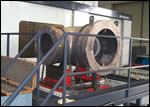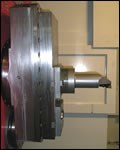Turning Without Rotating The Part
For large or unbalanced parts, this machining center can perform turning or boring operations using its programmable U axis.
Share








Takumi USA
Featured Content
View MoreA lathe with live-tool capability is not the only type of machine that can turn, mill and drill in the same setup. Parts that are too big or too unbalanced for chucking in a lathe can also benefit from combining these operations into one cycle. Instead of a lathe, the work can be done on a machining center featuring a U axis, because not all turning requires the part to spin.
One company supplying machining centers that can turn in this way is Trevisan USA (East Granby, Connecticut). The U axis is connected to the machine’s spindle, moving a turning or boring tool along the spindle’s radius to the desired machining diameter. The spindle then rotates this tool around the turned feature, which may be the OD of a flange or the ID of a bore. Because the U axis is programmable in a way comparable to the cross slide of a CNC lathe, contours and tapers can be turned. The machine can also perform single-point threading using standard lathe tools.
Valve bodies, with their bores and flanges, are examples of parts suited to this kind of machining. With the machining center’s B axis (beneath the table), such a part can be indexed so that bores and flanges facing in different directions can be turned in one cycle.
Milling cutters feeding in circles could also perform this work. However, turning instead of milling offers potential advantages. Turning can realize a finish that milling may not be able to achieve. Also, while side milling, face milling and machining the bore all are likely to require different tools, U-axis turning makes it possible to machine a flange’s OD, face and bore in a single, uninterrupted cut. Chamfers or radii can be machined in the same way. Thus, both the quality and the speed of cut stand to improve, says Trevisan USA sales manager Tom deMontigny.
The machines compete against more conventional turning as well, he says. Even if a large part is geometrically compact enough for machining on a lathe, chucking or clamping the part is likely to involve holding it at the opposite end of the part from the surface that is being machined. A machining center offers more options for clamping. The turned surface therefore might be machined more aggressively, because the rest of the part can be held more securely.
The Trevisan machine uses two different spindles, one for turning and one for milling and drilling, with different speed ranges and bearing arrangements for the different operations. The company’s machine models ranging from 450 mm to 1,400 mm in pallet size offer maximum turning diameters of 100 mm to 1,500 mm, respectively.
Related Content
-
Lean Approach to Automated Machine Tending Delivers Quicker Paths to Success
Almost any shop can automate at least some of its production, even in low-volume, high-mix applications. The key to getting started is finding the simplest solutions that fit your requirements. It helps to work with an automation partner that understands your needs.
-
Orthopedic Event Discusses Manufacturing Strategies
At the seminar, representatives from multiple companies discussed strategies for making orthopedic devices accurately and efficiently.
-
Which Approach to Automation Fits Your CNC Machine Tool?
Choosing the right automation to pair with a CNC machine tool cell means weighing various factors, as this fabrication business has learned well.





























.jpg;width=860)












.jpg;maxWidth=300;quality=90)
